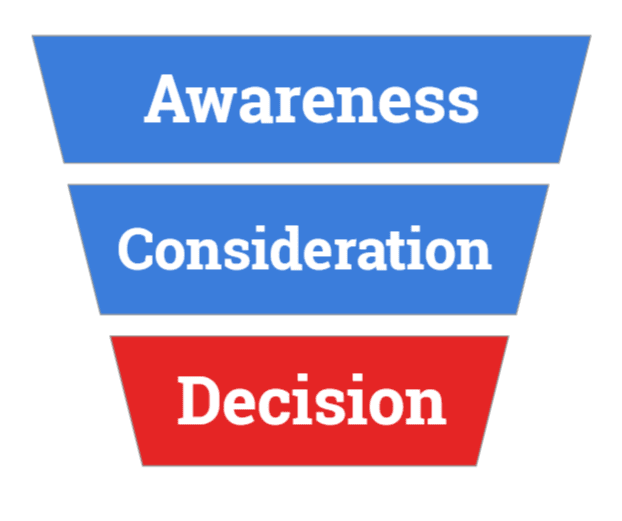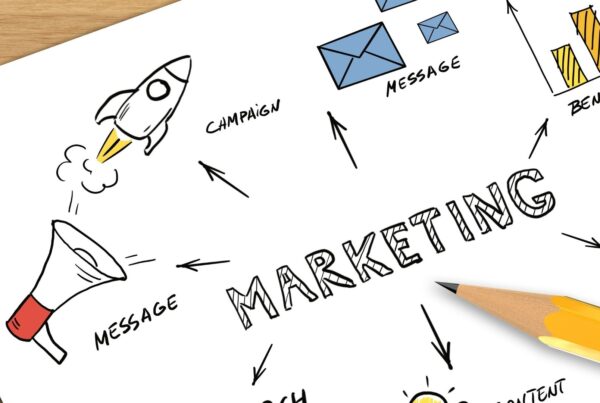In today’s buying process, your prospects have more power than ever before. It’s not just the abundance of options available to them or even the ease with which they can find different businesses in the area — it’s the ability to research their frustrations, educate themselves, and weigh their options in a highly educated and self-directed way.
So how do you stand out, and what can you do to help potential clients decide that you’re the best option for them?
In this post, we’ll show you what a modern buying process looks like and, hopefully, illuminate where and why prospects are falling out of your sales funnel. The buyer’s journey is more complicated than ever before, so it’s important to understand what stage your prospects are at so that you can provide the right information at the right time.
What is the Buyer’s Journey?
The buyer’s journey is the path your customers take to purchase, otherwise known as a sales funnel or pipeline. You can visualize it like this:
 The journey is defined by different stages, and each stage represents how ready your prospect is to make a purchase. Not everyone starts at the top — some people already have an idea of what product or service would solve their problem, and maybe have some specific brands in mind — but it’s important to understand each stage and what they entail.
The journey is defined by different stages, and each stage represents how ready your prospect is to make a purchase. Not everyone starts at the top — some people already have an idea of what product or service would solve their problem, and maybe have some specific brands in mind — but it’s important to understand each stage and what they entail.
The funnel above is a great tool for figuring out what kinds of information to give to your prospects since what content and interaction they want to experience from you will differ depending on where they are in the funnel.
Awareness Stage: Recognize The Problem

While many believe the buying process starts with shopping for products or services, it often begins before the buyer even knows what to shop for. Someone is experiencing a problem, but they aren’t quite sure what’s causing it. The first step, therefore, is all about diagnosing the problem — becoming aware of what is causing the issue.
At this stage, the buyer is looking for answers, resources, education, and insight. They want educational, third-party, vendor-neutral information so they can conduct “symptoms” research to decide if a problem exists and to more clearly define and name the problem.
In this stage, Buyers will be asking “who”, “what”, “where”, why”, and “how to” questions, either to their friends or their favorite search engine (or more than likely, both).
Let’s look at an example.
John has been experiencing some minor shoulder pain lately. Curious as to what is causing this pain, he goes to his desktop computer and searches for “common causes of shoulder pain.” A local physical therapist named Therapeutic Solutions appears in the search results, with a blog post that covers the most common causes of shoulder pain.
John sees some descriptions that match the pain he’s experiencing, eventually concluding he probably has arthritis. For now, the pain isn’t bad, so he doesn’t worry about looking into it further and is satisfied knowing why his shoulder hurts.
Notice that the content provided by Therapeutic Solutions doesn’t talk about themselves at all — it’s simply addressing shoulder pain and providing helpful information on what might be causing it. They know that John isn’t ready to buy at this point, he just wants to educate himself; they’ve curated their content to satisfy that need.
Keep in mind that the cause of a problem is sometimes more obvious and requires less research — for example, people who need to find a primary care doctor often don’t need to figure that out, they just know. That being said, those buyers can still find valuable information on the type of primary care physician that’s right for them.
Some questions John asked at this stage include:
- What causes shoulder pain?
- Why does my shoulder hurt?
- Where can I get my shoulder checked?
- What kinds of shoulder pain are there?
- How to cure shoulder pain
Consideration Stage: Research Potential Solutions

After identifying the cause of their pain, the modern buyer starts to consider various ways to solve it.
At this stage, the buyer has clearly identified their problem and is conducting research to figure out whether or not your product or service is a good fit for them. They’re focused on solutions and comparisons, exploring all avenues and types of options across industries to determine the best solution.
Let’s look at John again. It’s been a few weeks since he originally looked into his shoulder pain. While riding with a coworker to a meeting his shoulder starts to act up — it’s been getting worse lately — so he pulls out his phone and starts to look at ways to treat the pain. He reads a couple of articles from different sources that identify his options; everything is covered from basic stretches to invasive surgery.
John finishes his research on his tablet at home, coming to the conclusion that physical therapy is the best first step. Now he’s poised to find a business that fits his needs and budget.
The information John wants to see at this point is still vendor-neutral — he doesn’t want to know the specifics of any particular company, he just wants to know what his options are. However, this is a good opportunity to promote your solution over the alternatives. For example, even if you don’t promote your physical therapy services, you can still talk about the advantages of doing physical therapy over taking medicine or going through surgery.
Some questions John asked at this stage include:
- Best ways to treat arthritic pain?
- Should I treat my arthritis with medication or surgery?
- What do I need to fix my arthritis?
Decision Stage: Weigh Your Options

Finally, after picking a solution, the modern buyer will start shopping, looking at everyone who provides that solution. They’ll weigh the pros and cons of each and eventually decide on the option most attractive to them.
At this point, the buyer is figuring out exactly what it would look like to become a customer, whether it’s a customer of your company or one of your competitors. That means this is the time to talk about you. Let’s look at our scenario one last time.
John knows he wants to find a local physical therapist, so he starts searching for offices in his area. He may ask his friends for suggestions, but, like 93% of consumers, John looks to online reviews to help make his purchasing decision. So, he scours online review pages and customer comments.
While weighing his options, John sees the name Therapeutic Solutions again and again. This is the same business that helped him diagnose his problem at the beginning of the buying process. John is impressed by their website, which is designed well and portrays them as professional and experienced. They have many Google and Angie’s List reviews from current patients and one negative review that was responded to and handled appropriately.
During this final stage, John is looking to validate his decisions. If you’re trying to decide what kind of content to cover here, think about what information would help convince a potential client to choose you over the competition:
- Provide price comparisons
- Outline the pros of your solution over others
- Highlight customer testimonials and case studies
Whatever you do, focus on what sets you apart and make that front and center.
Some searches John conducted at this stage include:
- Best physical therapists in my area
- Free physical therapist consultation
- Physical therapists near me
Don’t Be Forgotten
If you’ve ever shopped online you understand that the buying process can be a long and sometimes painful process. With so much information at our fingertips it can feel like every purchase requires tons of research. And that’s exactly how people behave: search trends demonstrate that people not only want the best products available, they want products that perfectly fit their needs.
Because the buyer’s journey is a customer-navigated trip, with shoppers joining at various points, it’s important to have content that answers questions at each stage of that trip. You never know where your prospects will start the process, and providing the wrong information at any stage can push people away into the arms of your competition.
While there is no consistent number, most marketing and sales professionals will tell you that you need at least seven touchpoints with a prospect before they buy. And when you have a high-quality website and effective marketing efforts, it’s much easier to provide information to prospects without having your sales team interject in the process.
It also makes John’s buying process easier and will help him eliminate options that use less consistent or professional marketing materials.
Think about it like this: since the beginning of the buying process, Therapeutic Solutions provided helpful information to John and made sure he’d remember their name. As he identified his problems and decided on a proper solution, Therapeutic Solutions was there portraying themselves as highly trained medical professionals.
While this doesn’t guarantee that John will give them his business, he is much more likely to.
Start the Conversation
Interested in learning more about how our agency can help you stand out to your buyers in every stage of the funnel?



